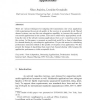91
Voted
JSAC
2008
15 years 21 days ago
2008
One of the key challenges in designing a rate adaptation scheme for IEEE 802.11 wireless LANs (WLANs) is to differentiate bit errors from link-layer collisions. Many recent rate a...
97
Voted
CN
2007
15 years 22 days ago
2007
We consider the flow-level quality of service (QoS) seen by a dynamic load of rate adaptive sessions sharing a bottleneck link based on fair share bandwidth allocation. This is o...
98
Voted
CORR
2008
Springer
15 years 25 days ago
2008
Springer
This paper studies the performance of hybrid-ARQ (automatic repeat request) in Rayleigh blockfading channels. The long-term average transmitted rate is analyzed in a fast-fading s...
109
Voted
SIGCOMM
2010
ACM
15 years 28 days ago
2010
ACM
Abstract--Vehicular WiFi access is distinct in two respects, (i) continuous mobility of clients and (ii) possibility of predictable link quality. As part of this study, we aim to c...
117
Voted
CONEXT
2009
ACM
15 years 1 months ago
2009
ACM
Dense, unmanaged 802.11 deployments tempt saboteurs into launching jamming attacks by injecting malicious interference. Nowadays, jammers can be portable devices that transmit int...
98
Voted
NETWORKING
2007
15 years 2 months ago
2007
While many existing rate adaptation schemes in IEEE 802.11 Wireless LANs result in severe throughput degradation since they do not consider the collision effect when selecting the...
105
Voted
CCECE
2009
IEEE
15 years 5 months ago
2009
IEEE
—This paper presents a capacity analysis of a decode-and-forward (DF) cooperative network with adaptive source transmission. Three different adaptive techniques are considered: (...
94
Voted
INFOCOM
2002
IEEE
15 years 5 months ago
2002
IEEE
There are various techniques for adapting the transmission rate of an application while maintaining the perceived quality at the receiver at acceptable levels. Shared channel syst...
95
Voted
WOWMOM
2005
ACM
15 years 6 months ago
2005
ACM
— We consider the design of optimal strategies for joint power adaptation, rate adaptation and scheduling in a multi-hop wireless network. Most existing strategies control either...
134
Voted
ICMCS
2005
IEEE
15 years 6 months ago
2005
IEEE
Streaming high quality audio/video (AV) from home media sources to TV sets over a wireless local area network (WLAN) is a challenging problem because of the fluctuating bandwidth...




